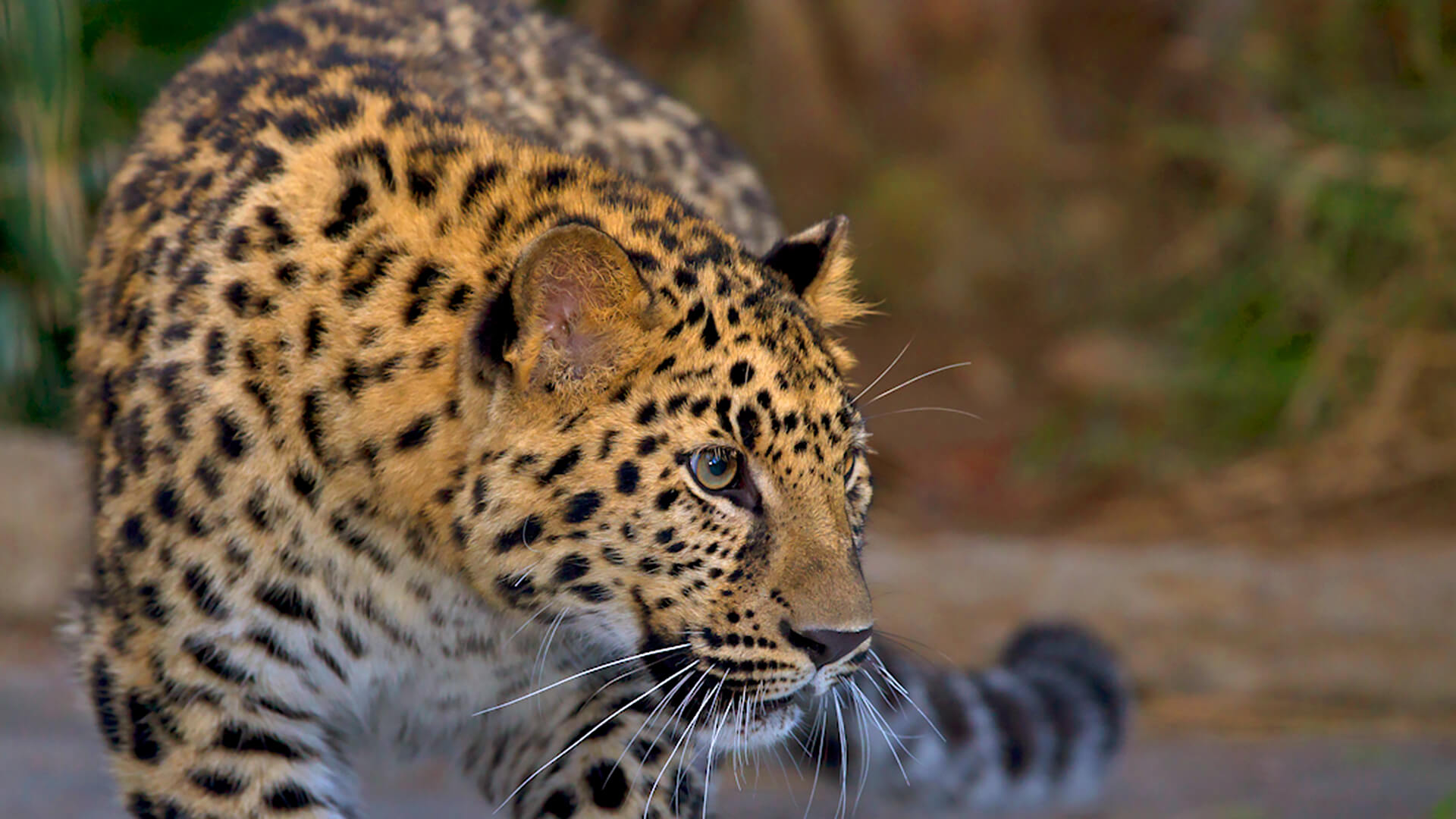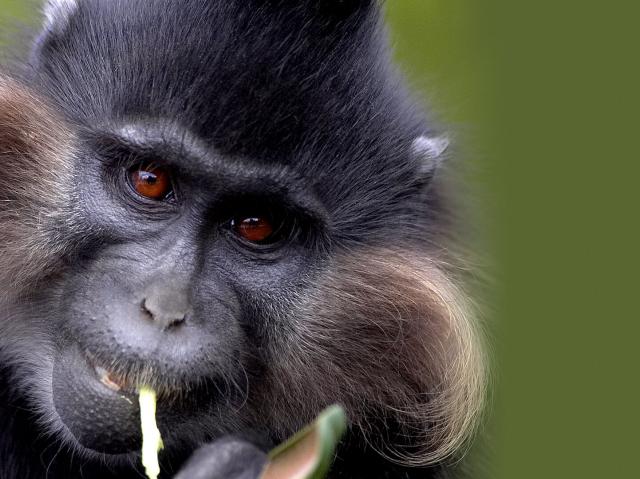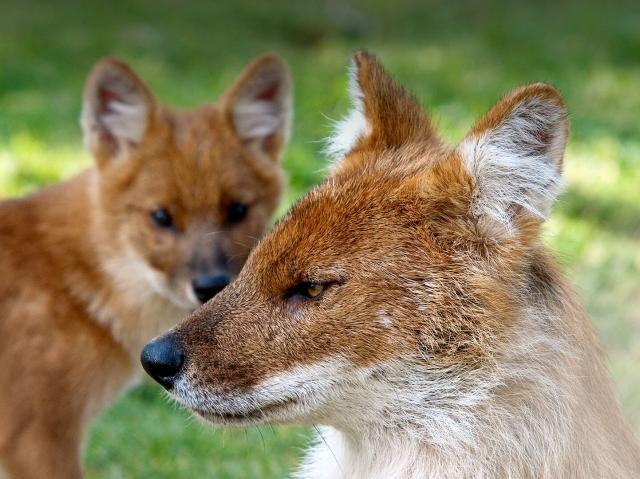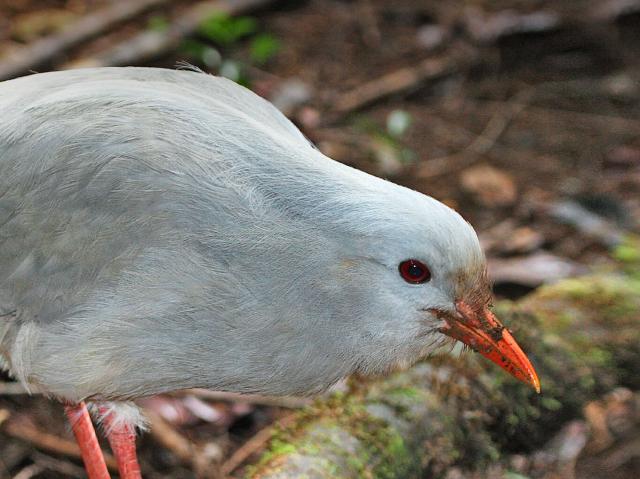
Leopard

- CLASS: Mammalia (Mammals)
- ORDER: Carnivora
- FAMILY: Felidae
- GENUS: Panthera
- SPECIES: pardus

ABOUT
The leopard is the epitome of stealth. Its very name brings mental pictures of this great spotted cat crouched on a tree limb awaiting the approach of a gazelle, or of a sleek, spotted body slipping silently through the dry savanna grass with scarcely a ripple as it nears its chosen target. Silence and stealth are the trademarks of this ultimate predator.
Leopards are the smallest of the large cats (to include lions, tigers, and jaguars) and are the most widespread, with subspecies found in Africa and Asia. They have a body structure similar to jaguars and are covered with flower-shaped spots on their backs called rosettes, with no dot in the center; the jaguar has a dot inside each of its rosettes. This profusion of spots helps leopards hide from their prey, breaking up their body outline in forests or grasslands.
Leopards living in dry grasslands are generally a lighter color than those found in rainforests. In the thick, dark rainforests of Southeast Asia, leopards that are nearly black can sometimes be found; these cats may look solid black at first glance, but their spotted pattern is visible in certain light.
Although a powerful and clever hunter, leopards are not always at the top of the food chain. In Africa, lions and packs of hyenas or painted dogs can kill leopards; in Asia, a tiger can do the same. Leopards go to great lengths to avoid these predators, hunting at different times and often pursing different prey than their competitors, and resting in trees to keep from being noticed.
HABITAT AND DIET
Leopards easily adapt to a wide variety of habitats, altitudes, and temperatures, from high mountains to deserts to rainforests. The largest leopards are named after the regions where they’re found, like the North African leopard and the Persian leopard. All can live without drinking water for as long as 10 days, getting the moisture they need from their food. All they need is some brush, thick vegetation, caves, or rocky terrain for hiding and hunting. Leopards usually rest during the heat of the day in bushes, rocks, caves, or even up in a tree, depending upon their habitat. Of the large cats, leopards are the most arboreal; they have long tails to help them to balance on narrow tree branches.
Unlike most cats, leopards are strong swimmers and are one of the few cats that like water, although they are not as aquatic as tigers. They are great athletes, able to run in bursts up to 36 miles an hour (58 kilometers per hour), leap 20 feet (6 meters) forward in a single bound, and jump ten feet (3 meters) straight up.
Leopards have incredible strength and can climb as high as 50 feet (15 meters) up a favorite tree while holding a fresh kill in its mouth, even one larger and heavier than themselves! They stash food up high so other predators such as lions or hyenas can’t get it. This way, leopards can return to eat more at a later time. One leopard was spotted dragging a 220-pound (100 kilograms) young giraffe into heavy brush to hide it. Leopards are usually nocturnal, resting by day and hunting at night.
Stories from both Africa and Asia tell of the leopard’s ability to enter a village and snatch a sleeping dog without being detected. The leopard is a champion hunter and has a variety of stealth attacks that catch its prey off guard. From dropping on prey out of trees to stalking prey at waterholes or in dry grasses, often slinking along on the belly, a leopard doesn’t have a predictable pattern to hunting.
The cat uses its vision, keen hearing, and whiskers, rather than its sense of smell, while hunting. The whiskers face forward when the leopard is walking and move back when the cat is sniffing; they stick out sideways when the leopard is resting. The big cat stalks and pounces rather than chases its prey over long distances. It grabs or swats prey, using retractable claws. Prey is killed with a bite to the throat. Leopards are carnivores and eat any meat item they can find: monkeys, baboons, rodents, snakes, amphibians, large birds, fish, antelope, cheetah cubs, warthogs, and porcupines.
FAMILY LIFE
Adult males and females find each other through scent, and a male may follow a female around for several days before she is ready to breed. Even then, a breeding encounter can be dangerous, as both cats have sharp claws and teeth and know how to use them!
A pregnant female uses a cave, burrow, or an opening in thick vegetation as a birthing den. She stays with her cubs, usually two or three in a litter, continually for their first few days before she finally ventures out for food. The cubs are born with little hair and their eyes are sealed. As they get older, Mom may have to leave her cubs for several days while she hunts. At about three months of age, the cubs venture out with their mother to learn hunting skills.
Like all young cats, leopard cubs like to play "stalk, pounce, and chase." Have you ever seen a house cat creep slowly after a bird or mouse? That's stalking. A quick leap and a grab with the claws is a pounce, and the chase comes if the prey gets away. Leopard cubs play by practicing these behaviors on their siblings and even on their mother. It's a good way to learn how to survive when they get older.
Young leopards are usually ready to head out on their own between 12 and 18 months and are ready to start a family of their own at two to three years.
Leopards rarely roar; their voice is more of a raspy bark. White spots on the tip of the tail and back of the ears help leopards locate and communicate with each other in tall grass. Except during breeding season, leopards lead a solitary life, marking their territory with urine, rubbing the face against rocks or tree trunks, scraping at the ground or rolling on it, and by shredding tree bark with their claws. Fighting between males is common and can be deadly.
CONSERVATION
Although the leopard is an adaptable cat, able to live in various habitats, some leopard subspecies are at critical risk. Leopard-skin coats were legal for many years and are still sold secretly. Many trees in leopard habitats have been cut down for building projects. Poachers kill leopards for their whiskers, which are used in some West African potions. Because leopards prey on livestock, ranchers trying to protect their animals frequently poison the large cats. All leopard subspecies are either endangered or threatened. The U.S. Endangered Species Act and the Commission on International Trade in Endangered Species (CITES) help protect leopards, as do wildlife parks in their home countries.
The Amur leopard, a subspecies living at the San Diego Zoo, exists on the cusp of extinction. As a conservation organization, we are working with other zoos to develop a sustainable and genetically diverse population of Amur leopards that can contribute to new scientific knowledge and to the survival of Amur leopards in restored and protected native habitat.
Monitoring populations of Amur leopards is critical to understanding population trends, which will determine the effectiveness of current conservation measures. The Amur Leopard and Tiger Alliance and its partner, the Wildlife Conservancy Society, have been monitoring the leopards since 1997. The cats (and other wildlife) have been surveyed in winter by counting tracks in the snow along established wildlife paths to estimate leopard density and population size. In 2002, trail cameras were added to allow conservation scientists to identify individual leopards by their unique spot patterns and monitor them over many years. Used year-round, the images uncover the secret lives of these cats walking, stalking, and rolling playfully on the ground. Cameras also photographed leopard prey, including sika deer, boars, and yellow-throated martens.
The Amur leopard is under siege from a variety of pressures including poaching of the leopards and their prey, loss of habitat due to forest fires, inbreeding due to tiny, isolated populations, human development and activities in their habitat, and lack of political commitment to conservation (a trend that is slowly shifting in the cats’ favor). Yet things are far from hopeless. The small but mighty population in Russia’s Primorsky Krai has remained mostly stable over the past 30 years, in spite of significant human pressures. Anti-poaching efforts and educational programs appear to be working. China has established a reserve that connects with leopard (and tiger) habitat in Russia, and there is a possibility of establishing a second population by reintroducing zoo-bred Amur leopards in Russia’s Far East.
The protection of leopards, their prey, and their habitat is finally improving. Through cooperative, committed, international conservation efforts, leopards will have something to “stalk about” for generations to come.
By supporting San Diego Zoo Wildlife Alliance, you are our ally in saving and protecting wildlife worldwide.
Sounds
LIFE SPAN
For leopards in human care, median life expectancy is about 18 years.
YOUNG
Gestation: 3 to 3.5 months
Number of young at birth: 1 to 6; usually 2 to 3 per litter
Weight at birth: 17 to 21 ounces (500 to 600 grams)
Age of maturity: 3 years
SIZE
Length: 3 to 6.2 feet (92 to 190 centimeters)
Weight: Females weigh 46 to 132 pounds (21 to 60 kilograms); males weigh 80 to 165 pounds (36 to 75 kilograms)
Tail length: 25 to 39 inches (64 to 99 centimeters)
FUN FACTS
Leopards can hear five times more sounds than humans, even the ultrasonic squeaks made by mice.
When it's time for a rest, leopards like to climb trees and sprawl out on the branches. They are the largest cats to climb trees regularly.
Although snow leopards and clouded leopards have “leopard” in their common name, they are different enough from the true leopards to have their own classifications within the cat family.
The character Bagheera in Rudyard Kipling’s The Jungle Book was described as a black panther, which is really a very dark-colored leopard.










